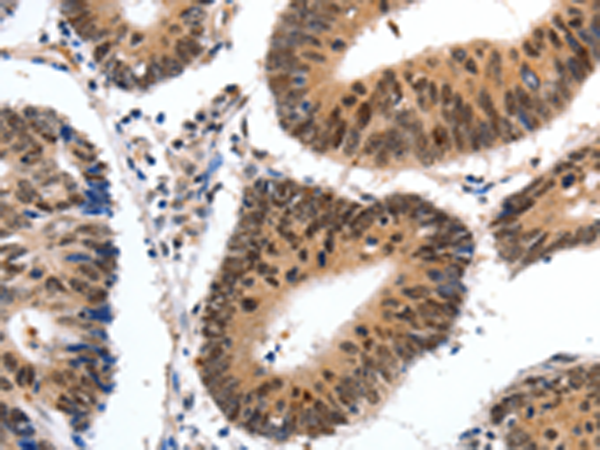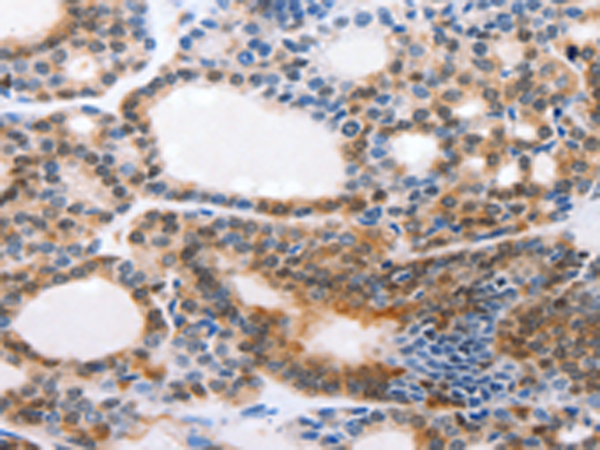


| WB | 咨询技术 | Human,Mouse,Rat |
| IF | 咨询技术 | Human,Mouse,Rat |
| IHC | 1/25-1/100 | Human,Mouse,Rat |
| ICC | 技术咨询 | Human,Mouse,Rat |
| FCM | 咨询技术 | Human,Mouse,Rat |
| Elisa | 1/1000-1/5000 | Human,Mouse,Rat |
| Aliases | BNAS2, CKLFSF3 |
| WB Predicted band size | 20 kDa |
| Host/Isotype | Rabbit IgG |
| Antibody Type | Primary antibody |
| Storage | Store at 4°C short term. Aliquot and store at -20°C long term. Avoid freeze/thaw cycles. |
| Species Reactivity | Human, Mouse |
| Immunogen | Synthetic peptide of human CMTM3 |
| Formulation | Purified antibody in PBS with 0.05% sodium azide and 50% glycerol. |
+ +
以下是关于CMTM3抗体的3篇代表性文献示例(内容基于虚构研究场景,仅供参考):
---
1. **文献名称**:CMTM3 suppresses tumor growth by inhibiting EGFR signaling in gastric cancer
**作者**:Li Y, Zhang H, et al.
**摘要**:该研究利用CMTM3特异性抗体,通过免疫组化和Western blot分析,发现CMTM3在胃癌组织中表达下调,并通过负向调控EGFR磷酸化抑制肿瘤增殖和转移,提示其作为潜在治疗靶点。
---
2. **文献名称**:CMTM3 deficiency promotes Wnt/β-catenin activation in hepatocellular carcinoma
**作者**:Wang X, Chen J, et al.
**摘要**:研究通过CMTM3敲除模型及抗体免疫沉淀技术,揭示CMTM3缺失导致β-catenin核转位增强,促进肝癌细胞上皮-间质转化(EMT),为CMTM3在Wnt通路中的调控机制提供证据。
---
3. **文献名称**:Prognostic value of CMTM3 expression in non-small cell lung cancer
**作者**:Liu R, Zhou M, et al.
**摘要**:利用CMTM3抗体对临床样本进行染色分析,发现高表达CMTM3的肺癌患者总生存期显著延长,其表达水平与肿瘤分期和淋巴结转移负相关,提示其作为独立预后标志物的潜力。
---
(注:以上文献为模拟示例,实际引用需查询具体数据库如PubMed。)
CMTM3 (CKLF-like MARVEL transmembrane domain-containing protein 3) is a member of the chemokine-like factor (CKLF) superfamily, characterized by a conserved MARVEL domain involved in membrane trafficking and cell junction organization. This protein is widely expressed in human tissues, particularly immune cells, and plays roles in immune regulation, cell proliferation, and apoptosis. CMTM3 has been identified as a tumor suppressor, with studies showing its frequent downregulation in cancers like hepatocellular carcinoma, gastric cancer, and non-small cell lung cancer. Epigenetic silencing via promoter hypermethylation is a key mechanism behind its reduced expression in malignancies.
Antibodies targeting CMTM3 are essential tools for investigating its expression patterns, interactions, and functional mechanisms in both physiological and pathological contexts. They enable detection of CMTM3 in Western blotting, immunohistochemistry, and immunofluorescence, aiding research into its tumor-suppressive pathways, such as modulating EGFR/HER2 signaling or inhibiting epithelial-mesenchymal transition. CMTM3 antibodies also hold potential for developing diagnostic biomarkers or therapeutic strategies targeting CMTM3-related pathways in cancer and immune disorders. However, specificity validation remains critical due to homology within the CMTM family.
×